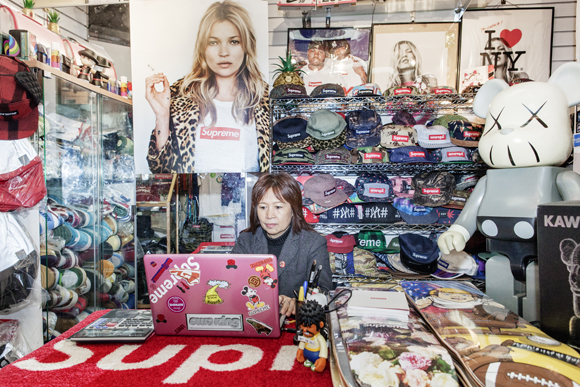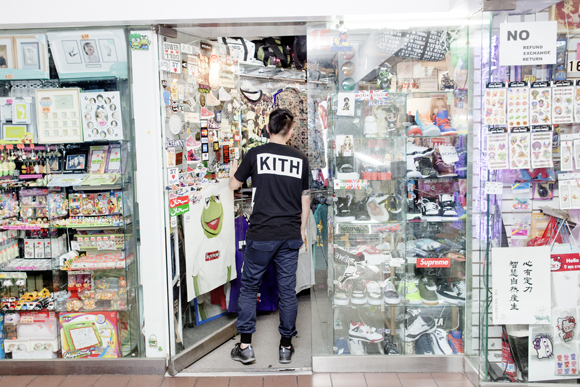Inside a run-down mall off of Elizabeth Street in Chinatown, down an escalator to the basement and past a raft of empty storefronts, is a minuscule store, the size of a walk-in closet, that’s quietly at the center of a peculiar global fashion empire. It has no sign and it’s not on the mall directory. It’s impossible to find on Google.
The enterprise, which its owner refers to as Unique Hype Collection, is in the business of buying clothing from the skate-inspired men’s fashion brand Supreme at retail prices, waiting until the items have sold out at Supreme’s physical stores and online shop, and then putting those items up for sale in the mall and on eBay at significant markups. Much of its merchandise goes to Japan, where Supreme goods can cost twice what they do here at retail. On a recent Friday afternoon, a cap that had gone on sale on Thursday at Supreme for forty-eight dollars was on the shelf at Unique Hype Collection for eighty-five dollars, where teen-agers were eyeing it jealously. The store even uses authentic Supreme shopping bags, recycled from purchases made at Supreme.
“I’ve brought in seven figures a year for the last two years,” said Peter, the owner of the store, a thirty-year-old who refused to give his last name or be photographed. “I can’t show my face—I’m under a lot of eyes,” he said, sitting on a stool inside Unique Hype Collection last week. (Peter was actually under only four eyes: two posters of Lady Gaga looking at the camera while modelling a Supreme T-shirt hung on the ceiling above him.) “I do everything myself. With the eBay store, I even pack it and ship it myself,” he said, before pausing and thinking about this for a second. “Actually, I don’t drive myself. I have a driver.”
Peter, who was born in Guangzhou, refers to himself as a “major flipper,” a businessman who will buy and resell, well, anything: “clothing, real estate, food, anything. Like, the day after Obama was elected, I got copies of the Daily News for fifty cents each. I bought every copy. Now they’re twenty dollars!” He adds, “I used to do green-tea Kit Kats. You could sell the bags for sixteen dollars each. There were only two stores in New York that had them, so I called the stores and told them I wanted to buy everything they had whenever they got the Kit Kats in.”
Peter, who has been buying and wearing Supreme clothing since the nineteen-nineties, communicates with other “major flippers” online, discussing potential markets and keeping tabs on the companies whose wares they sell. One major flipper, username “croatianstyle,” a friend of Peter’s (“I party with him when I go to Cali”), recently got a call from Nike after he bought a hundred pairs of Air Yeezy sneakers, the ones designed by Kanye West that can sell for upwards of five thousand dollars a pair on eBay. Peter was more careful: “I only got thirty-five pairs. He attracted too much heat. Too much attention.” Because Peter and other resellers deal in goods whose demand generally wildly exceeds their supply, they don’t compete with each other on price. “If they want to undercut me on price, go ahead. I’ll wait until they sell out and then sell them for even more!”
Supreme clothing is Peter’s signature stock in trade, although he resells a handful of pieces by similar menswear brands if their prices are right. (He also owns a collectible-card store.) The real Supreme has been based out of a store on Lafayette Street in SoHo since it was established in 1994 (and now operates stores in London, Los Angeles, and six in Japan). It was founded by the then-thirty-year-old British émigré James Jebbia, who also had a hand in starting up the downtown skate meccas Union and Stüssy. He is now known among fans of Supreme for his reclusiveness and gruff demeanor, especially with the press, because of his dissatisfaction with Supreme being pigeonholed as skateboarding clothing, and therefore crappy.
Now Kanye West, Drake, Lil Wayne, and Justin Bieber wear its gear. Jeff Koons, Takashi Murakami, Damien Hirst, and Richard Prince have designed some of its skateboard decks.Hypebeast, a popular men’s fashion Web site, operates a message board on which a posting about Supreme’s current season has generated more than five million views and nearly eighty thousand replies. Some users post their salaries and discuss how much Supreme clothing they can buy after they pay their taxes. When the brand releases a new season of clothing, Supreme fans set up a sidewalk tent city outside the Lafayette Street store, sleeping on the street for as long as six days for the chance to get the first crack at the merchandise.
Some of the people standing in the Supreme line are secretly Peter’s employees, mostly teen-agers whom he recruits for the line-standing job while they mill around in his collectible-card store. “Everybody has a price,” he notes. “Sometimes it’s only fifty dollars.” The usual rate is a hundred dollars per day of waiting in line. There’s no bonus for inclement weather. He hires between ten and thirty people to stand in line each time Supreme releases clothing, which is generally every Thursday. How do the kids know what to buy? “They know what to buy cuz they been working for me for quite some time lol,” Peter explains via text message.
Supreme has reached its level of popularity through business practices that most brands would find unconscionable. The brand, as a whole, does not seem eager to please. The in-store staff is mostly aloof, surly. (In the nineteen-nineties, staff members were known for walking up behind customers and menacingly telling them that they could not touch the clothing until they bought it.) Staff members keep a handful of sold-out items in the back for when their friends come in. The store’s speakers play rap and heavy metal at nearly wall-shaking volume in the middle of the afternoon. Perhaps most important, the brand makes a lot of clothing that its employees know they will not sell—they sometimes express surprise that customers are buying certain items.
This season, Supreme is selling a zip-up hoodie with a quotation, attributed to the skateboarder Mark Gonzales, that reads, in bright letters across the back, “I’ve never wanted to piss on someones face more than I want to piss on yours.” Many of Supreme’s items sell out online within seconds of going on sale, but the “Piss Face Zip-Up” has not sold out in any color after weeks on the Web site. “I didn’t stock any,” Peter explained. (Perhaps Peter miscalculated—mysteriously, the Piss Face Zip-Up, which costs a hundred and thirty-eight dollars, is sold out in blue in Japan, where it costs two hundred and fifty-eight dollars and thirty cents.)
In the event that an item does sell, according to Peter, Supreme has a plan: “Every other brand besides Supreme sees a design that sells out, and so they make it over and over. But if Supreme knows an item is selling, they’ll stop making it, never make it again, and try something else.” This is why, as Peter explains, “Supreme is the only brand whose clothing becomes more expensive as time passes. Every other brand, except Polo maybe, if you don’t sell it this season, it’s not going to move.”
Inside Unique Hype Collection on a recent Thursday, three teen-age shoppers jostled for space, literally bumping into each other. There was nowhere to stand. Two more, who couldn’t fit, waited their turns outside. Peter wore a Supreme football jersey. On a stool behind the counter sat Lam Xie, Peter’s mother, who gives her age as “fifty-two or fifty-three.” She runs the day-to-day operations and speaks with an encyclopedic knowledge of Supreme clothing and Nike skateboarding sneakers. Her expertise is unexpected in the context of her otherwise limited command of English. She is proud to note that people who work at Supreme are aware of Unique Hype Collection—the brand’s employees have been there.
Ms. Xie grew up in China and got a business degree before moving to the United States and working as a babysitter, which is what she was doing when Peter asked her to run the store. Although many of her customers know her by name and greet her like an aunt, she occasionally embodies the same brusque attitude toward customers that Supreme itself does: “People say it is expensive? You don’t buy! You say, ‘Is it real or fake Supreme?’ If you don’t know, you don’t buy! Get out, don’t buy.”
Photographs by Lauren Lancaster.








